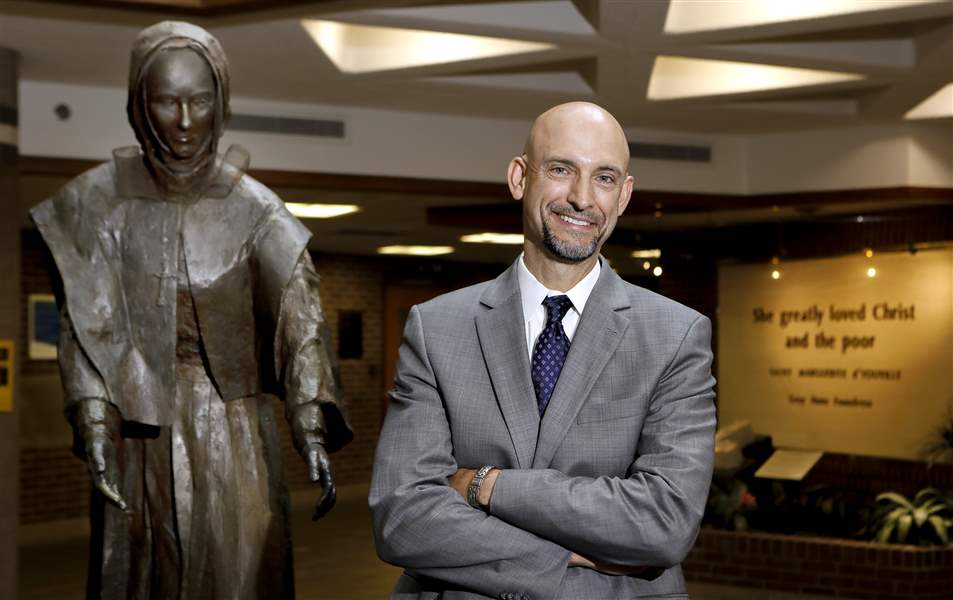
Baxter sees opportunities, challenges in new role as leader of Mercy Health-Toledo
11/5/2017
Bob Baxter, new president of Mercy Health-Toledo, sees opportunities for growth in the system.
THE BLADE/ANDY MORRISON
Buy This Image
As Bob Baxter settles into his new role as president and CEO of Mercy Health-Toledo, his first message is clear: While the leadership has changed, the mission has not.
Mr. Baxter, 49, sees opportunities for the system to grow in providing access to under-served communities, through partnerships with community organizations, and in future construction projects.
He was named president and CEO in October after serving in an interim role since June. He succeeds Dr. Imran Andrabi, who left in June to become president at ThedaCare, a hospital system in northeast Wisconsin.
WATCH: Bob Baxter sits down with Lauren Lindstrom to talk access to healthcare
Mr. Baxter also will continue as president and CEO for Mercy Health-Lima, a position he has held since 2012. Daily leadership duties in Lima primarily are in the hands of Mercy Health St. Rita’s Medical Center President Dale Gisi.
Mr. Baxter’s dual role makes way for stronger ties between the two regions to better serve patients across northwest Ohio, he said. Some of those ties were already in the works, such as combining the call center for ambulance and life flight services. But he sees opportunities to better connect services such as pediatrics and neuroscience.
Since making the move official, Mr. Baxter has been meeting leaders inside the system and across the Toledo community. One place he sees an opportunity to be a community leader is in the fight against the area’s opioid epidemic, which has hit urban areas like Toledo and the more rural communities around Lima’s Allen County alike.
He was pleased to learn about Mercy Health’s partnership in the Drug Abuse Response Team through the Lucas County Sheriff’s Office.
“I think that whether you’re in a large or small community, it’s about having the right partners and collaborators at the table,” he said. “The mental health board or social service providers, housing, every community is going to have its own unique challenges.”
Jeff Dempsey, president of Mercy Health St. Vincent Medical Center and Children’s Hospital, said Mr. Baxter’s experience in the Mercy Health system and in northwest Ohio made it easy for him to move to a new role. Mr. Dempsey called Mr. Baxter a “mission-focused leader.”
“He has jumped right aboard, and he has been there to support us,” Mr. Dempsey said. “He has done an amazing job to reach out to medical staff and community leaders right away.”
Mr. Baxter said recent construction projects, including a new emergency and surgical emergency center and a new hospital underway in Perrysburg, are concentrated in areas where officials project growth and increased need for services.
He alluded to “other opportunities for expanding access” that aren’t to the point of public discussion.
One way to sustain the health of the area and growth in the system is educating and retaining bright young medical professionals, he said. That includes investing in residency programs across the system.
“We want to not only provide a great education for these young men and women to go out and be amazing practitioners, but also we want to find individuals who are interested in serving this community that is expending resources to help them get trained,” he said.
The Lima region received accreditation this month to begin four residency programs, though Mr. Baxter declined to divulge which specialties will be featured until more details are finalized. A new neurology residency will begin in Toledo next year, he said.
But physical expansions must be paired with growth in opportunities for health-care access, particularly for low-income and otherwise disadvantaged patients.
“We’re always going to be a champion of making sure that access to services for the poor and under-served is maintained,” he said. “We feel like we need to have a voice in those conversations, whether that’s on a state level or a national level.”
As the future of the nation’s health-care laws is in a constant state of flux, Mr. Baxter said Mercy Health officals need to be adaptable yet ready to bring their concerns to state and federal lawmakers. Proposed cuts to Medicaid and decreased reimbursements to hospitals from government payers pose two particular challenges.
“We know the environment is changing,” he said. “We also have a chance to be a player, especially on the state level.”
But as changes are abundant, Mr. Baxter said he is intent on continuing the work that began in Toledo more than 163 years ago.
“While we’ve had a leadership change in terms of my role, we’re still serving the same mission,” he said. “Our overall approach to care, to making sure that we provide access to resources, to keeping patients at the center of what we do really hasn’t changed. That momentum continues, that focus continues.”
Contact Lauren Lindstrom at llindstrom@theblade.com, 419-724-6154, or on Twitter @lelindstrom.